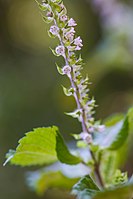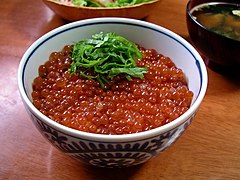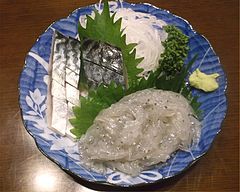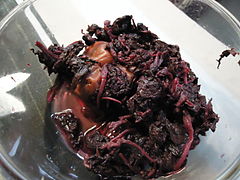Japan
Japanese names for shiso types| Red shiso (f. purpurea) | Shiso (紫蘇) |
| Akajiso (赤紫蘇) |
| Ruffled red shiso (f. crispa) | Chirimen-jiso (縮緬紫蘇) |
| Green shiso (f. viridis) | Aojiso (青紫蘇) |
| Ōba (大葉) |
| Ruffled green shiso (f. viridi-crispa) | Chirimen-aojiso (縮緬青紫蘇) |
| Bicolor shiso (f. discolor) | Katamen-jiso (片面紫蘇) |
| Variegated shiso (f. rosea) | Madara-jiso (斑紫蘇) |
Shiso (紫蘇) is extensively used in Japanese cuisine. Red, green, and bicolor varieties are used for different purposes.
Red shiso is called akajiso (赤紫蘇). It is used in the making of umeboshi (pickled plums) to give the plums a red color. The leaves turns bright red when steeped in umezu , the vinegary brine that results as a byproduct of pickling plums. [31] [32] It can also be combined with umezu to make certain types of sushi. In the summer, it is used to make a sweet, red juice. In Kyoto, red shiso and its seeds are used to make shibazuke, a type of fermented eggplant. [33]
Red leaves are dried and pulverized into flakes, then mixed with salt to make a seasoning called yukari. [34] The word yukari is an ancient term for the color purple, and was first used by Mishima Foods Co. to describe their shiso product, though the word is now used to refer to shiso salt in general. [35] [36] Red shiso leaf flakes are a common ingredient in furikake seasonings, meant to be sprinkled over rice or mixed into onigiri (rice balls).
Green shiso is called aojiso (青紫蘇) or ōba (大葉 "big leaf"). It is used to garnish noodle dishes like hiyamugi or sōmen , meat dishes like sashimi, tataki and namerō , and tofu dishes like hiyayakko . Whitebait (shirasu) sashimi is often garnished with green shiso. Whole leaves are also used as receptacles to hold wasabi, or tsuma (garnishes). Leaves can also be battered on one side and fried to make tempura, and are served with other fried items. [37] Chopped leaves are used to flavor any number of fillings or batter to be cooked, for use in warm dishes. In Japan, pasta is sometimes topped with dried or freshly chopped shiso leaves, which is often combined with raw tarako (pollock roe). [38] Green shiso has even been used in pizza toppings in lieu of basil. In the summer of 2009, Pepsi Japan released a seasonal flavored beverage, the green colored Pepsi Shiso. [39]
Shiso seed pods (fruits) are called shiso no mi, and are salted and preserved like a spice. They can be combined with fine slivers of daikon (radish) to make a simple salad. [40] Oil pressed from the seeds was once used for deep-frying. [31]
Shiso sprouts, buds and cotyledons are all called mejiso (芽紫蘇), and used as garnish. Red sprouts are called murame, and green sprouts are called aome. [41] Although not often served in restaurants, mejiso are used as microgreens.
Shiso flowers are called hojiso (穂紫蘇), and used as garnish for sashimi. They are intended to be scraped off the stalk with chopsticks, and added as flavoring to the soy sauce dip. The flowers can also be pickled.











![Kansaifoods Co., Ltd.[Li Wan ] Shou Si .jpg](http://upload.wikimedia.org/wikipedia/commons/thumb/0/0c/Kansaifoods_Co.%2C_Ltd.%E3%80%8C%E5%8A%9B%E4%B8%B8%E3%80%8D%E5%AF%BF%E5%8F%B8.jpg/240px-Kansaifoods_Co.%2C_Ltd.%E3%80%8C%E5%8A%9B%E4%B8%B8%E3%80%8D%E5%AF%BF%E5%8F%B8.jpg)








